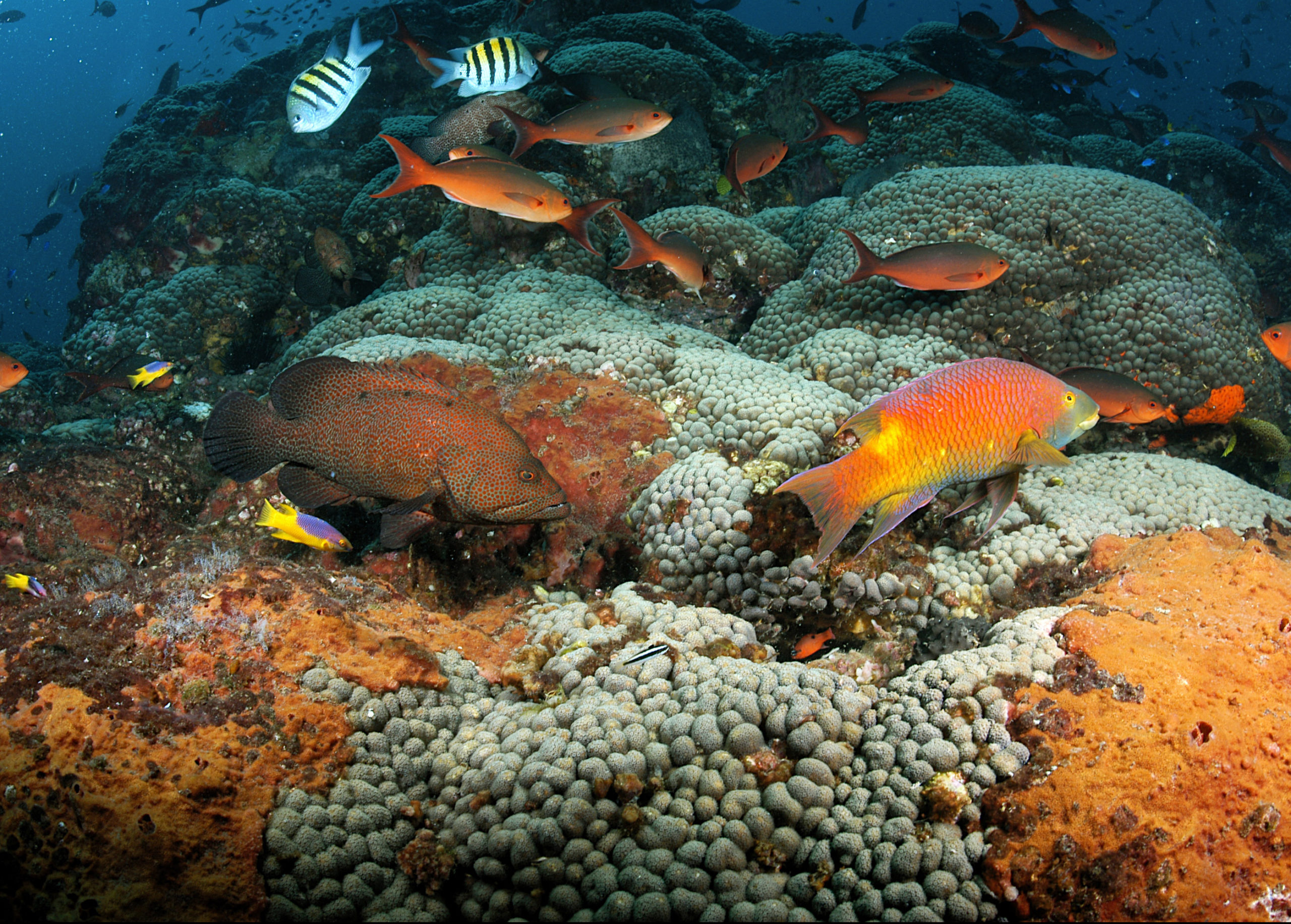
16 Fascinating Facts about our 16 National Marine Sanctuaries and Monuments
January 4th is National Trivia Day! In honor of this day of factoids, here are fascinating facts about each national marine sanctuary and marine monument in the National Marine Sanctuary System that you should learn to dominate your next trivia night. Let’s get learning!
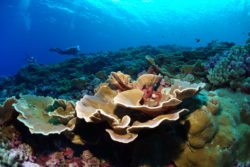
Coral reef off Swains Island in National Marine Sanctuary of American Samoa. Photo: Wendy Cover/NOAA
American Samoa
The National Marine Sanctuary of American Samoa is a hallmark of biodiversity and protects extensive coral reefs including some of the oldest and largest Porites coral heads in the world. The largest and oldest coral head is more than 500 years old and over 6 meters high. What’s the name of this coral head?
Answer: Big Momma! Get an underwater look at Big Momma and other coral heads protected within National Marine Sanctuary of American Samoa here.
Channel Islands
North of Channel Islands, Monterey Bay National Marine Sanctuary earned the nickname “Serengeti of the Sea” because of its diverse and rich habitats including healthy beaches, tide pools, kelp forests, steep canyons, and an offshore seamount teeming with life. Channel Islands also earned a nickname for its diversity of wildlife and ecosystems. What is Channel Islands’ nickname?
Answer: Its nickname is the “Galapagos of North America.” Channel Islands National Marine Sanctuary protects exceptional biodiversity, productive ecosystems, important species and habitats, prized fishing grounds, and maritime heritage artifacts. From its deep-sea coral communities to lush kelp forests, this national marine sanctuary definitely lives up to its nickname.
Cordell Bank
Cordell Bank National Marine Sanctuary is an extremely productive marine area off northern California, just west of the Gulf of the Farallones. In the late 1800s, there was strong incentive to survey the coast of California to promote safer maritime commerce. During this time of exploration, George Davidson, a hydrographer with the U.S. Coastal Survey, discovered a “shoal west of Point Reyes” on a mapping expedition. Following the discovery, another accomplished surveyor was sent to conduct additional surveys and relocate the shallow shoal, now named after him as Cordell Bank. Who was this surveyor?
Answer: Edward Cordell. Although George Davidson discovered Cordell Bank National Marine Sanctuary, Edward Cordell fully mapped it.
Florida Keys
Florida Keys National Marine Sanctuary is known for its nationally significant marine resources including North America’s only living coral barrier reef (and the world’s third largest), but the sanctuary is also home to incredible shipwrecks and rich maritime heritage. Within the sanctuary is a trail of historic shipwrecks, scattered along the coral reefs a few miles off shore. Can you name one (or all) of the nine ships of Shipwreck Trail?
Answer: Adelaide Baker, Amesbury, Benwood, City of Washington, Duane, Eagle North America, San Pedro, and Thunderbolt.
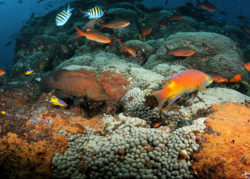
Stetson Bank in Flower Garden Banks National Marine Sanctuary. Photo: G.P. Schmahl/NOAA
Flower Garden Banks
Flower Garden Banks National Marine Sanctuary is famous for the underwater communities that rise from three underwater mountains called salt domes. Formed 10,000 to 15,000 years ago, these coral reef communities are a complex, balanced ecosystem, supporting both shallow and deep-water species including majestic rays, rare fish, and sea turtles. The sanctuary protects three distinct banks. Can you name them?
Answer: East Flower Garden Bank, West Flower Garden Bank, and Stetson Bank. Each of these communities have their own unique food webs and characteristics and all support some of the healthiest coral reefs in the Caribbean and Western Atlantic region.
Gray’s Reef
Gray’s Reef National Marine Sanctuary lies off the coast of Savannah, Georgia. It protects the calving ground of an incredibly important and critically endangered species of whale. This whale is among the rarest of all large whales and migrates to the sanctuary during the winter to birth. Do you know which species it is?
Answer: North Atlantic Right Whale. Estimates say there are less than 450 of these whales remaining. Learn more about these gentle giants here.
Greater Farallones
Greater Farallones National Marine Sanctuary began as Point Reyes – Farallon Islands National Marine Sanctuary in 1981. Then, the sanctuary was renamed Gulf of Farallones National Marine Sanctuary in 1987. The name of the sanctuary officially changed to the Greater Farallones National Marine Sanctuary in 2015.Which President designated the original sanctuary?
Answer: President Jimmy Carter
Hawaiian Islands Humpback Whale
As the name suggests, Hawaiian Islands Humpback Whale National Marine Sanctuary protects and conserves humpback whales. Like humans, humpback whales have a unique “fingerprint” that allows us to identify them. They have different color variations and markings on a specific part of their body. Where do we find this unique “fingerprint”?
Answer: Flukes (or tail)! During research trips and response efforts, the sanctuary documents whales which results in a fluke catalog comprised of well over 1,000 individuals and growing.
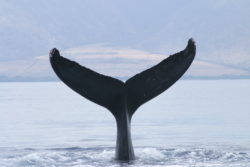
A diving humpback whale showing off his fluke in Hawaiian Islands Humpback Whale National Marine Sanctuary. Photo Credit: NOAA
Mallows Bay – Potomac River
Mallows Bay-Potomac River National Marine Sanctuary is the newest addition to the sanctuary system. It was designated after a 19 year lull in new sanctuaries. What year was it designated?
Answer: It was officially designated in 2019! Mallows Bay-Potomac River is a time capsule of history in Southern Maryland that includes Native American culture, Revolutionary and Civil War era activity, Potomac River steamboat transports, historic commercial fishing operations, and the “Ghost Fleet,” the submerged remains of more than 100 wooden steamships.
Monitor
Monitor National Marine Sanctuary protects the wreckage of the famous Civil War Battleship, USS Monitor, and the graves of its heroes. The USS Monitor was the first ironclad warship commissioned by the Union Navy and deployed in what battle against the CSS Virginia (formerly the Merrimack) in 1862?
Answer: The Battle of Hampton Roads. The Monitor and Virginia fought the Battle of Hampton Roads on March 9, 1862 with the two sides withdrawing (but both claiming victory). While there was no clear winner in the battle, the Monitor did prevent further damage to the Union fleet.
Monterey Bay
Home to the nation’s largest kelp forests and one of North America’s largest underwater canyons Monterey Bay is the 11th national marine sanctuary out of 14. It was designated in the same year that the Olympics were hosted in Barcelona, Dry Tortugas National Park was designated, and the Mall of America opened. What year was it designated?
Answer: 1992
Olympic Coast
More than 56 species of seabirds call Olympic Coast National Marine Sanctuary home, including the Tufted Puffin! Puffins are powerful flyers, reaching speeds upwards of 50 miles per hour. To achieve this speed, they beat their wings approximately how many times a minute?
Answer: Upwards of 400 times a minute! Another fun fact: unlike other birds, tufted puffins need a running start to take to the air!
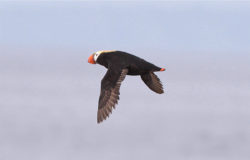
Tufted Puffin flying over Cordell Bank National Marine Sanctuary. Photo: Sophie Webb/NOAA SWFSC
Papahānaumokuākea
The Northwestern Hawaiian Islands Marine National Monument was established by Presidential Proclamation in 2006. One year later, it was given its Hawaiian name, Papahānaumokuākea. Where does the name come from?
Answer: Papahānaumokuākea commemorates the union of two Hawaiian ancestors – Papahānaumoku and Wākea – who gave rise to the Hawaiian Archipelago, the taro plant, and the Hawaiian people. Papahānaumoku is a mother figure personified by the earth and Wākea is a father figure personified in the expansive sky. Both are highly honored and recognized ancestors of Native Hawaiian people.
Rose Atoll
Rose Atoll is one of the most pristine atolls (ring-shaped reefs) in the world! In 2012, Rose Atoll Marine National Monument was incorporated as part of the National Marine Sanctuary of American Samoa during its expansion. One of Rose Atoll’s most famous features is the stunning pink color of its fringing reefs. How does Rose Atoll get its pink color?
Answer: The color comes from the crustose coralline algae (CCA) that grows on its fringing reefs. The algae grows as a crust over and between gaps in the coral reefs to “cement” them together. Its shallow reefs are dominated by the CCA making it distinct from the other nearby islands.
Stellwagen Bank
Stellwagen Bank National Marine Sanctuary was named after Henry S. Stellwagen, a Lieutenant of the U.S. Navy on loan to the Coast Survey. Henry was the first to notice a feature that wasn’t represented on any of the official maps. Over several months in 1854, he mapped the bank in its entirety which the U.S. Coast Survey recognized as an incredibly important discovery. Why was Stellwagen Bank considered an important discovery?
Answer: Back in the 1800s, current radar and sonar technologies did not exist. Instead, ships relied on different navigational tools like taking soundings by lowering a weighted line into the water to determine depths. The newly-discovered bank became an underwater feature that would warn ships that they had left the greater Gulf of Maine and were approaching dangerous waters which is especially important when navigating in riskier weather.
Thunder Bay
Sailors gave Thunder Bay the nickname “Shipwreck Alley” because of its unpredictable weather, murky fog banks, sudden gales, and rocky shoals. The name is justified as the sanctuary is home to one of the nation’s best-preserved, nationally-significant collections of shipwrecks. More than 100 wrecks have been discovered including two ships that met their fate when they collided with each other on October 20, 1854. Luckily, both crews of the ships were able to deploy lifeboats and make an escape despite the speed at which the two ships crashed. Which shipwrecks were these?
Answer: The John J. Audubon and the Defiance. J.J. Audubon is a 170-foot long, wooden two-mast schooner and the Defiance is a schooner that was built in 1848 with “apple cheeked” bows. These ships mark a time when demand was high for faster vessels for navigating the Great Lakes. Unfortunately, they met their end when the Defiance sailed through Lake Huron on a foggy night. At the same time, J.J. Audubon was traveling north to Chicago and the two ships collided off Presque Isle, Michigan, in part due to the north and southbound sailing routes that brought ships dangerously close to one another. Both vessels sank to the bottom within minutes, ultimately settling only a few miles away from each other at the bottom of Lake Huron.
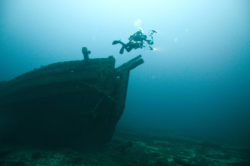
The wreck of John J. Audubon in Thunder Bay National Marine Sanctuary. Photo: Doug Kesling/NOAA
